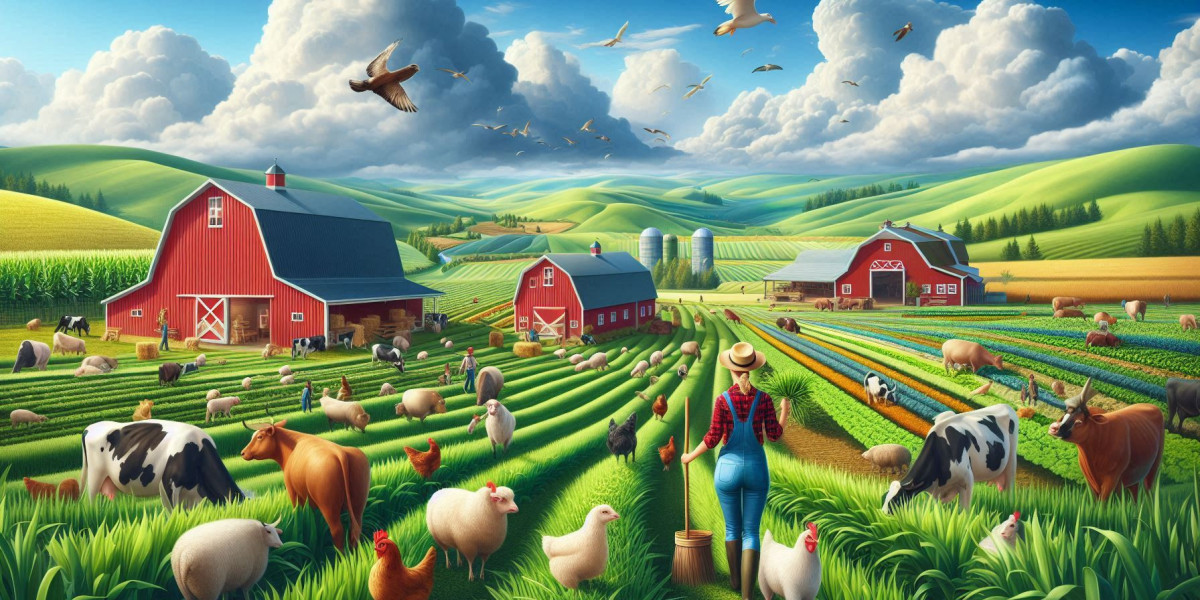Introduction
Big farms, also known as large-scale or industrial farms, play a crucial role in global food production. These agricultural enterprises cover vast areas of land, utilize advanced farming technologies, and produce significant quantities of crops, livestock, and dairy products. With the world’s population continuously growing, big farms are essential in meeting the increasing demand for food.
In this comprehensive guide, we’ll explore the benefits, challenges, and future trends of big farms. Whether you’re a farmer, investor, or simply curious about modern agriculture, this article will provide valuable insights into the world of large-scale farming.
What Are Big Farms?
Big farms are agricultural operations that span hundreds or even thousands of acres, focusing on high-efficiency production. These farms leverage economies of scale to maximize output while minimizing costs. They often specialize in:
Crop Production (wheat, corn, soybeans, cotton)
Livestock Farming (cattle, poultry, pigs)
Dairy Operations (milk, cheese, butter)
Specialty Farming (organic, hydroponic, or greenhouse farming)
Unlike small family farms, big farms rely heavily on machinery, automation, and precision agriculture techniques to enhance productivity.
Advantages of Big Farms
1. Higher Productivity & Efficiency
Big farms use advanced equipment like GPS-guided tractors, automated irrigation systems, and drones to optimize planting, harvesting, and monitoring. This leads to higher yields with fewer labor requirements.
2. Economies of Scale
By operating on a large scale, big farms reduce per-unit production costs. Bulk purchasing of seeds, fertilizers, and equipment allows them to negotiate better prices, increasing profitability.
3. Consistent Food Supply
Large farms contribute significantly to food security by producing massive quantities of staple crops and livestock. They help stabilize food prices and ensure a steady supply to supermarkets and export markets.
4. Technological Advancements
Big farms are early adopters of agri-tech innovations, including:
Precision Farming (soil sensors, variable-rate technology)
Automated Machinery (self-driving harvesters, robotic milkers)
Data Analytics (predictive modeling for weather and crop health)
5. Job Creation & Economic Impact
Despite automation, big farms still employ thousands of workers in roles ranging from field labor to agronomists and logistics managers. They also boost local economies by supporting ancillary industries like transportation, packaging, and food processing.
Challenges Faced by Big Farms
While big farms offer numerous benefits, they also encounter several challenges:
1. High Initial Investment
Setting up a large farm requires substantial capital for land, machinery, and infrastructure. This makes it difficult for small farmers to transition into large-scale operations.
2. Environmental Concerns
Large-scale farming can lead to:
Soil Degradation (due to over-farming and monocropping)
Water Depletion (excessive irrigation)
Pollution (fertilizer runoff, pesticide overuse)
Sustainable farming practices, such as crop rotation and conservation tillage, are essential to mitigate these issues.
3. Dependence on Government Policies & Subsidies
Many big farms rely on government subsidies to remain profitable. Changes in trade policies, tariffs, or climate regulations can significantly impact their operations.
4. Labor Shortages
Despite automation, some farming tasks still require manual labor. Seasonal worker shortages, especially during harvest seasons, can disrupt production.
5. Market Volatility
Fluctuating commodity prices, trade wars, and changing consumer preferences (e.g., shift toward organic food) can affect profitability.
Also checkout more games: big farms
The Future of Big Farms
As technology and sustainability become increasingly important, big farms are evolving in several ways:
1. Adoption of Smart Farming
The integration of Artificial Intelligence (AI) and Internet of Things (IoT) devices will further optimize farming processes. Predictive analytics will help farmers make data-driven decisions on planting, irrigation, and pest control.
2. Sustainable & Regenerative Agriculture
To combat climate change, big farms are adopting:
No-Till Farming (reduces soil erosion)
Cover Cropping (improves soil health)
Renewable Energy (solar-powered irrigation, biogas from manure)
3. Vertical & Urban Farming
Some large agricultural companies are investing in vertical farming—growing crops in stacked layers indoors. This method uses less water and land while enabling year-round production.
4. Blockchain for Supply Chain Transparency
Consumers increasingly demand to know where their food comes from. Blockchain technology helps track food from farm to table, ensuring quality and ethical sourcing.
5. Expansion of Organic & Non-GMO Farming
As health-conscious consumers drive demand for organic products, big farms are dedicating more acreage to pesticide-free and non-GMO crops.
How to Start or Invest in a Big Farm
If you’re interested in entering large-scale farming, consider these steps:
1. Conduct Market Research
Identify profitable crops or livestock based on regional demand, climate, and soil conditions.
2. Secure Financing
Explore loans, grants, or partnerships with agricultural investors. Government programs often support large farming initiatives.
3. Acquire Land & Equipment
Purchase or lease fertile land and invest in high-quality machinery for planting, harvesting, and processing.
4. Implement Technology
Adopt farm management software, automated systems, and precision agriculture tools to maximize efficiency.
5. Focus on Sustainability
Incorporate eco-friendly practices to ensure long-term viability and compliance with environmental regulations.
Conclusion
Big farms are indispensable to modern agriculture, providing the majority of the world’s food supply. While they face challenges such as environmental impact and market volatility, technological advancements and sustainable practices are shaping their future.
Whether you’re a farmer looking to scale up or an investor exploring agribusiness opportunities, understanding the dynamics of big farm is crucial. By embracing innovation and sustainability, large-scale farming can continue to feed the growing global population efficiently.
Final Thoughts
Big farms drive food security and economic growth.
Technology and sustainability are key to their future success.
Investing in large-scale agriculture requires careful planning and adaptation to industry trends.








